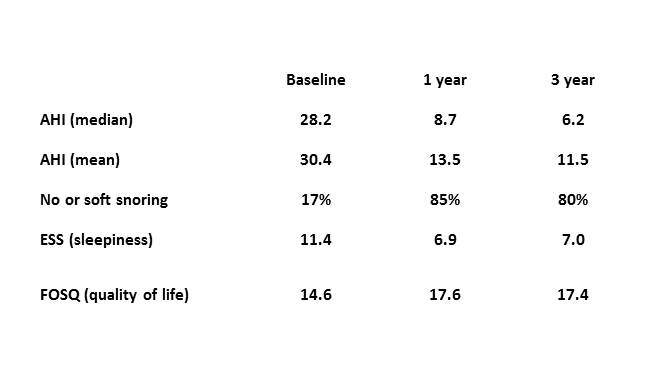Excellent outcomes at 3 years after implantation of the Inspire Medical Upper Airway Stimulation system were reported in the January 2016 issue of the medical journal Otolaryngology–Head and Neck Surgery. Many types of sleep apnea surgery have solid research evidence demonstrating multiple benefits, from improvements in health and sleep quality (treating sleepiness and quality of life) to reductions in snoring. However, one of the limitations of sleep apnea surgery research–like all fields of medicine–is that most studies are performed over focused periods of time, examining patients typically at 3-6 months following surgery.
This study followed patients receiving Upper Airway Stimulation through the STAR Trial. It showed that the benefits of Inspire Medical Upper Airway Stimulation seen at 1 year after implantation remain unchanged over a 3 year period. This is an important finding because we obviously want patients to continue receiving the benefit of any sleep apnea surgery over long periods of time. In this study, the results at 3 years were, if anything, slightly better than those reported in the previous study of 1 year outcomes. The results are shown below and indicate that Upper Airway Stimulation achieves meaningful, lasting improvements in sleep apnea and its consequences, such as snoring, sleepiness, and decreased quality of life.

Just as important as the benefits of any sleep apnea surgery are the risks. It was equally important that there were almost no adverse events related to the Upper Airway Stimulation system that appeared between 1 and 3 years. The only one was removal of the system in one patient with insomnia, presumably because they could never get comfortable with the system.
Why should you come to Keck Medicine of USC when considering Inspire Medical Upper Airway Stimulation?
At Keck Medicine of USC, we were the first center in the western United States to offer Inspire Medical Upper Airway Stimulation for obstructive sleep apnea. We remain one of the leading centers in the country–with Upper Airway Stimulation as well as other sleep apnea surgery procedures. We have definitely seen this kind of benefit in our own patients, and we believe that patient evaluation and treatment selection are key parts of obtaining good results with all sleep apnea surgery options. It is important that an essential part of screening patients for Upper Airway Stimulation is drug-induced sleep endoscopy, and I am one of the world’s experts in this evaluation technique for sleep apnea surgery. For an example of the kind of benefits that we see, one of my patients was featured in a KCBS segment on Upper Airway Stimulation. If you are interested in learning more, please see the Upper Airway Stimulation page on my main website.



Antonio Orozco, DDS says:
I am working on getting a referral from my primary physician so you can evaluate my airway to see if tongue reduction can help me with my OSA. I have had 4 or 5 surgeries, including the Inspire implant but I still have about 17 AHI’s along with the symptoms that go with it.
I have noticed my tongue at rest sticks out about 25 mms beyond the border of my lips. if I stick my tongue out while using the inspire implant the headache is reduced. Everything I read about tongue resection has to do with posterior tongue resection. Is the anterior part of tongue ever resected to reduce OSA? (I apologize if it is a stupid question)
Dr. Kezirian says:
The anterior part of the tongue plays such an important role in speech and swallowing that tongue resection typically is very limited in the anterior tongue and more typically addresses the tongue base (back of the tongue). It is also the tongue base that can become enlarged, for example, with fat deposition associated with weight gain.